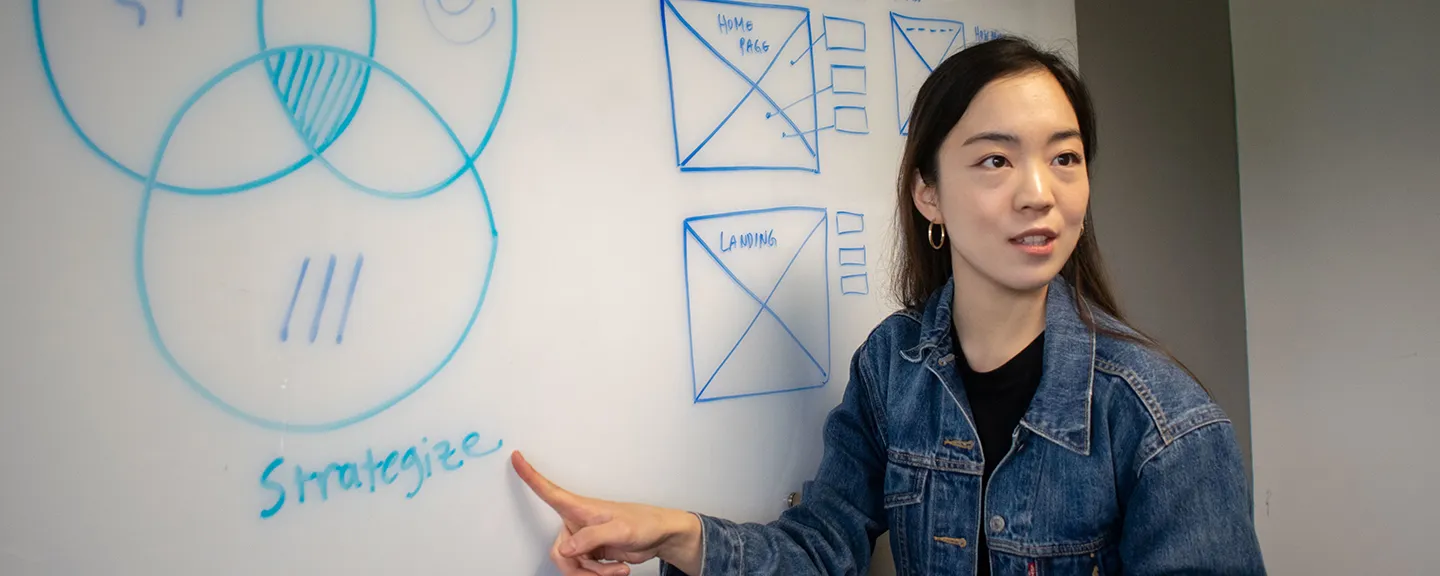- Home
- >
- APU Articles
- >
- News Article
Meet Jess Paik, Director of APU’s New Master of Arts in UX Design Program
January 28, 2020 | Written By Stephanie Thurrott

Jess Paik, MEd, recently joined Azusa Pacific University as assistant professor and director for the new Master of Arts in User Experience Design program. Her arrival coincided with the launch of the UX design program, which is expected to draw strong interest from students. This low-residency graduate program approaches human-centered design from an artistic perspective, preparing students for careers in this fast-growing field.
Paik brings with her a solid background in education and artistic expression. She studied visual arts at the Orange County School of Arts before majoring in painting and history of visual culture at the Rhode Island School of Design.
As a Fulbright Research Scholar, she studied the psychology of portraiture and identity in her research of the Diversification of Western and Eastern Aesthetics. However, during this artistic research in South Korea, she discovered her passion for teaching when she volunteered to teach English to North Korean refugee students. Facing barriers in communication and culture, the refugee students connected with Paik through creative workshops and visual art-centered learning. That trend has continued well into her teaching career.
Connecting Design and Education
Paik’s interest in creative and visual teaching and learning led her toward design education, and she earned her master’s degree in education from the Harvard Graduate School of Education. As she got more interested in technology, media, and design media as creative sources for transforming the learning experience, she became more passionate about developing innovative curriculum around design. She credited a large part of that motivation to her thoughts and ideas around how design thinking impacts the character, social, and reflective growth within students.
“User experience is one of the subjects that I became interested in because it expands beyond the visual elements of design, and goes deeper into understanding the audience and users in order to create connection and understanding. This leads designers to develop a strong sense of empathy,” Paik noted.
Building Access Through Innovation
It was a design project assigned to her in graduate school that lit this fire within Paik. As she and her teammates worked on the assignment, they experimented with ways to make visual art more accessible to people with visual impairments. Specifically, she and the team focused on Claude Monet’s painting “Charing Cross Bridge: Fog on the Thames.” They used software to link specific colors in the painting to computer-generated sounds. Then, a cellist translated each sound into a musical note.
After researching the painting’s history and story, the cellist used both the story and computer sounds to create a cohesive musical piece that represented the painting. Paik and her team dubbed the finished product “Translations.” “Our team aimed to create a meaningful experience for those who cannot see the painting, but can still listen to the colors and emotions of a painting,” she said.
Solving Problems Using UX Design
Paik explained that UX design is how people identify and observe everyday problems, and UX design professionals frame everyday observations into tasks that address, solve, and create plans to resolve an issue. In fact, she said that UX design is closer to many people’s lives than they may think!
Additionally, Paik noted that she hopes to explore how visual language can become more universal—similar to computer science language—and can resonate with people from different cultures who have diverse interpretations and languages.
In the UX design program at Azusa Pacific, Paik explained that she wants her students to excel in visual literacy and research, becoming interactive and personable researchers and designers. “I will encourage in-field work and research so that students do not become distant researchers relying on collected data, but those who learn to immerse themselves into the experiences of a group,” she said.
Diversity Benefits User Experiences
Paik also noted that she enjoys and appreciates working with diverse UX design program students. She said that she’s very interested in understanding the types of inspirations and stories designers look back to when innovating—and how they continue to evolve their original ideas as they interact with others.
“I like witnessing the many different ways people interpret one challenge,” Paik explained. “People come from different backgrounds, upbringings, and cultures, which I believe inform their problem solving and creative ideas.”
For one project, Paik said she plans to have her students build a recipe using only visual icons and elements. “Students will need to research and discover the best visual forms and methods of communication,” she noted. “This project is meant to take students out of the digital context in UX design, and to work on developing their visual literacy and skills in observation and experimental research.”
Creativity pushes technology forward, bringing people closer together and solving global issues. Are you interested in learning more about the UX design program at Azusa Pacific University? Get the details about this low-residency master’s degree that can propel your career.